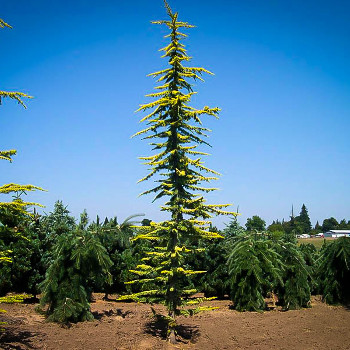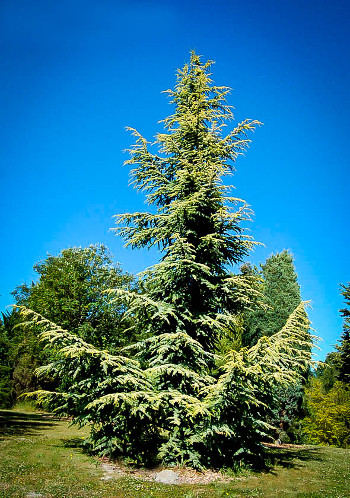Cedar Trees
Aromatic, regal, and essentially care-free. Say hello to Juniper's big brother.
Aromatic, regal, and essentially care-free. Say hello to Juniper's big brother.
Most of the world has trees known as cedars, but the real picture isn’t a simple one. Many trees that are called cedars technically aren’t, but that’s the familiar name for them and the arguments of biologists aren’t likely to change it now. The true cedars are trees in the genus Cedrus, up to four species of conifers that grow naturally from the western Himalayas to the shores of the Mediterranean. There’s actually a much larger number of cypress species commonly known as cedars though, including the Eastern White Cedar in the USA. From a gardener’s point of view there’s a huge variety of cedars available, irrespective of exact botanical classification, so there will almost certainly be one that suits your garden.
As always with choosing tree it’s important to be absolutely sure of what you want before purchasing. Cedars can be long-lived, and some species can also grow extremely large – 230 feet or more. Before you plant one make sure you have the space for it.
Cedars don’t need a lot of care, but some help in getting them established is always welcome. Before making the decision to plant one you should make sure you have all the information you’ll need to get the best out of it.
Cedars are satisfying to grow, but if conditions aren’t right a young tree may not survive. You’ll maximize your chances by buying a high quality one from a reputable nursery like The Tree Center, that’s been well cared for in the early stages of growth; a healthy sapling will establish itself more quickly and be more resistant to pests and disease. Look at the choice of cedars available, pick the one that’s best for your garden then order with confidence from The Tree Center.
Sun: Plant in full sun where possible. They will tolerate part shade, but are likely to grow more slowly.
Water: Water immediately after planting, then every two days for the first month. Check every few days through the first three growing seasons and water any time the root zone looks dry.
When to plant: The best time to plant cedars is in fall, as this will let the roots establish themselves through the winter.

Once the tree is planted water it well, and repeat every two days or so for at least the first month – more often if you’re having a dry spell. If the soil isn’t very rich consider adding some liquid fertilizer to the water.
Deer and rabbits like to snack on young cedar shoots, so if these animals have access to your garden consider protecting your tree with a chicken wire cage until its crown has grown safely out of their reach.
Cedar trees can be slightly sensitive about the soil they’re planted in, although with such a wide range of species some are more tolerant than others. In general you should look for a spot with slightly alkaline soil that’s moist but well drained – but check our page for your specific tree. The Atlas Cedar, for example, prefers acidic soil. Others, like the Northern White Cedar, will grow well in either.
If you do want a tree that doesn’t match your soil pH don’t worry; you can modify it enough to get the tree established and growing well. For alkaline-loving species, like Lebanon cedar, mix some lime into the soil when you plant the tree. Neutral or alkaline soil can be made acidic with rock sulfur or peat moss.
While cedars need moisture, they won’t tolerate waterlogged soil; this is likely to cause root rot. If your garden has a water feature make sure you plant your cedars at least three feet from the edge of the water. Try to avoid anywhere that’s prone to flooding; they can survive the occasional flood, but long periods will harm them.
One final thing to beware of is that cedars send strong roots straight down. Ensure the soil in your chosen location is deep, and be careful not to plant them over sewers, buried cables or anything else they might damage. Cedar roots can cause havoc with water pipes and drains.
Cedars are middle of the road when it comes to water. They do best in moist soil, but too much water will soon leave them struggling. If your soil tends to retain water a cedar may not be ideal. Small specimens may do well in a raised bed but large cedars will send down deep taproots that extend past any practical drainage measures you can install. However if you have medium-weight, loamy or sandy soil they should do well.
An established cedar is quite drought tolerant but for the first three years consider laying a soaker hose around the root zone during dry spells, and turn it on for an hour or two each day to make sure the roots stay moist.
If your soil conditions are ideal, a cedar shouldn’t need mulch or fertilizer, but there are occasions when they can be useful. If the weather is dry and you’re having to water regularly an organic mulch will help retain moisture around the roots and save you some water. It will also keep the roots cool. Tailor your mulch to the species and soil, though. Some of them can alter the pH, so make sure it will do so in a way that benefits the tree. If your garden isn’t too rich in nutrients mulch that biodegrades can enrich it, which will reduce the need for fertilizer.
Fertilizing can be controversial among cedar growers. The fact is it usually isn’t necessary unless your soil is in poor condition. If there’s a decent amount of humus in the ground your cedar will get all the nutrients it needs from that. However rocky soil or very sandy patches will benefit from fertilization. A slow release type can be used long term if required. Otherwise, especially for younger trees, go with a liquid.

With so many different cedars to choose from there’s no such thing as a typical example. The range of sizes, forms and habits is truly immense. Here are some popular examples to give you an idea of what’s available.
Native to mountainous regions around the Mediterranean, the Lebanon Cedar Tree is a large species that in the wild can reach 130 feet tall. When it’s young it has a conical form – this is what’s shown on the Lebanese flag. As the tree gets older the horizontal branches tend to die near the bottom and spread out higher up, creating a broad, flat-topped crown. This species is quite drought-resistant, being used to dry climates.
Technically a cypress tree, the Atlantic White Cedar can be found on the Atlantic coast from Maine to Georgia. Wild specimens can reach a hundred feet or more, but cultivated ones are more often around 60 feet. It tends to take a tall, conical form with a very straight trunk This is a water-loving tree and a good choice if you have wetter ground – it can stand occasional flooding.
Again this isn’t a true cedar; it’s more closely related to the cypresses. The Japanese Cedar is a very striking tree but only suitable for the largest gardens; it can grow extremely large, often well over 200 feet. Its timber has a fresh smell and is very light, making it popular for ornamental boxes.
Cedars are prized by gardeners for their looks; they’re very distinctive evergreens that will maintain interest all year round. Many species make good shade trees, especially when mature. They also tend to be fast-growing, so you don’t have to wait decades to have an imposing specimen in your garden. The cones they produce are a valuable food source for many birds and small mammals.
There are few serious health concerns with cedars. The usual pests may affect most species – aphids, scale and some borers. Other cedars are highly resistant to insects though. Their wood has long been valued for its fragrance, and the reason for that fragrance is chemicals that deter pests; if you choose one of these varieties you’re much less likely to have issues with boring insects, although moths may still feast on the needles. Tip blight can be an issue in some cases but overall these are robust and adaptable trees once they’ve become established.





